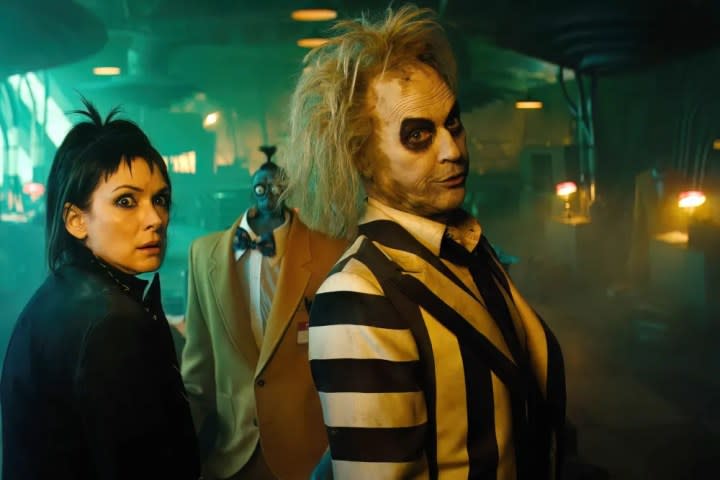7 best Winona Ryder movies, ranked

Winona Ryder’s reprisal of the role of Lydia Deetz — now mother to a teenage daughter — in Tim Burton’s Beetlejuice Beetlejuice marks a turning point in her career. Making her film debut at 15, Ryder was Hollywood’s defining teenager for much longer than she actually was a teenager (she was playing 18 as late as age 28).
Her vaunted innocence was so much the rule that a simple shoplifting arrest in 2001 shut down her career for half a decade. Now, as she settles into the role of perpetual on-screen mom in the aftermath of Stranger Things, seems an appropriate time to reflect on the variegated career that’s brought us here.
7. Beetlejuice (1988)

Forget the fan-service sequel — the appeal of the original Beetlejuice was its total lack of adherence to contemporary franchise-building parameters. The lore was largely unexplained (what exactly were those sandworms?), the needle drops idiosyncratic and kooky rather than cravenly orchestrated, and the title character (Michael Keaton, the ghost with the most) appears for a total of 17 minutes.
Ryder is the real main character here, and she projects an ethereal but warm presence that renders her ridiculous parents (Jeffrey Jones and the ever-fantastic Catherine O’Hara) grotesques by comparison.
6. Edward Scissorhands (1990)

The rare original screen story that feels like an authentically Gothic fairy tale, Tim Burton’s fourth feature, which he conceived of in his teens, established trends to which he’d return again and again. Johnny Depp plays an unfinished android whose incomplete hands are clusters of razor-sharp blades.
Ryder plays the sugar-sweet suburban teen who falls in love with him. Sure, why not? Scissorhands has the saccharinity and manicured edges of John Waters’ more garish films, but unlike them, it never tilts over the line into sourness, even subtextually.
5. Little Women (1994)

Less sweeping and perspectival than Greta Gerwig’s 2019 version but also, in its own way, truer to its source material (most obviously in its conclusion), director Gillian Armstrong’s Little Women is very nearly stolen by My So-Called Life‘s Claire Danes, whose performance as third-born March daughter Beth traces a delicate arc to an inescapably tragic conclusion.
But Ryder’s wide-eyed, open-faced Jo is an effective audience surrogate, and the soft-edged, Christmas-tinged Americana of Armstrong’s film is an apt frame for the performance.
4. The Age of Innocence (1993)

This adaptation of Edith Wharton’s superb Gilded Age romance novel was a complete departure for director Martin Scorsese (he made the movie between Cape Fear and Casino) and star Daniel Day-Lewis (an unlikely quietly agonized lover between his forceful turns in 1992’s The Last of the Mohicans and 1993’s In the Name of the Father).
The movie, which is weaker than the book but still affecting, places Ryder in the disadvantaged position of cuckolded, virginal fiancé to Day-Lewis’s Newland Archer. While being very nearly abandoned in favor of Michelle Pfeiffer is no one’s idea of a good time, Ryder is excellent here in her earnest, angelic mode (also to be found in Bram Stoker’s Dracula and Edward Scissorhands).
3. Heathers (1989)

Quick! Cover the heading to this section. Now, tell me — what 1980s film was written to be three hours long, intended to be directed by Stanley Kubrick, and originally ended with an extended sequence set in the afterlife? If you guessed Heathers, you either have a vivid imagination or chose not to cover the heading to this section as instructed.
From the bizarre master plan of screenwriter Mark Waters, Heathers, featuring Ryder hot off Beetlejuice, became the definitive high-school satire, keener in its use of metaphor than Mean Girls and boasting significantly more murders and explosives. It ain’t Kubrick, but it’s honest work.
2. Black Swan (2010)

The perpetual ingénue, Ryder’s art imitated life as, at 39, she played a prima ballerina forced into retirement. (Hollywood tends to discard former teen beauties when they reach their unspeakable late 30s –the previous year, Ryder had played the mother of Zachary Quinto, six years her junior, in the Star Trek reboot.) As Beth McIntyre, a star of her troupe supplanted by Natalie Portman’s unstable obsessive, the chain-smoking, scowling Ryder perfectly exemplifies the rage of the passed-over.
The film itself, like all of Darren Aronofsky’s work, is effortlessly engaging in its jagged-edge intensity. But unlike its closest relative among Aronofsky’s filmography, Requiem for a Dream (2000), it’s not a cacophony of cascading disasters but a seemingly inevitable trajectory toward the macabre and (possibly) supernatural.
1. Mermaids (1990)

In a year in which she had three starring roles (Edward Scissorhands and Welcome Home, Roxy Carmichael being the other two), the 19-year-old Ryder earned her first Golden Globe nomination for this manifestly wonderful family dramedy. Richard Benjamin’s film of Patty Dann’s novel was designed as a post-Moonstruck showcase for Cher, who plays the eccentric and sexually voracious single mother of two teen daughters (Ryder and Christina Ricci).
But Ryder (with help from Ricci) walks off with the movie with her note-perfect performance of a teen on the cusp of becoming an adult. Establishing Ryder as perhaps the most insistently believable teenager in the last 35 years of American cinema, the performance, while under-watched, is indelible, and has to be seen.
